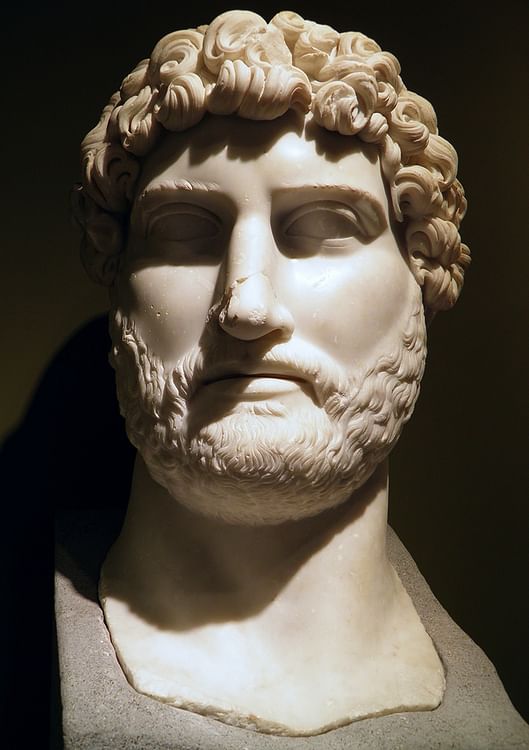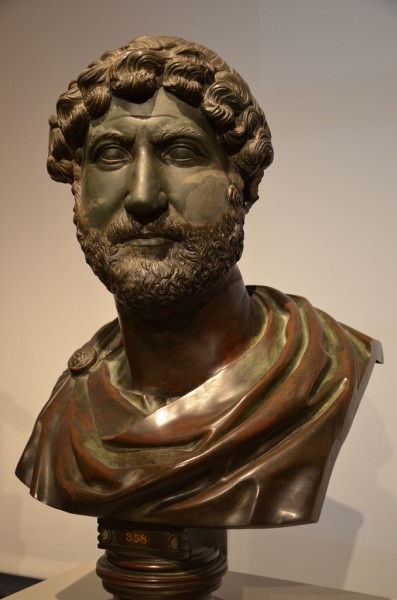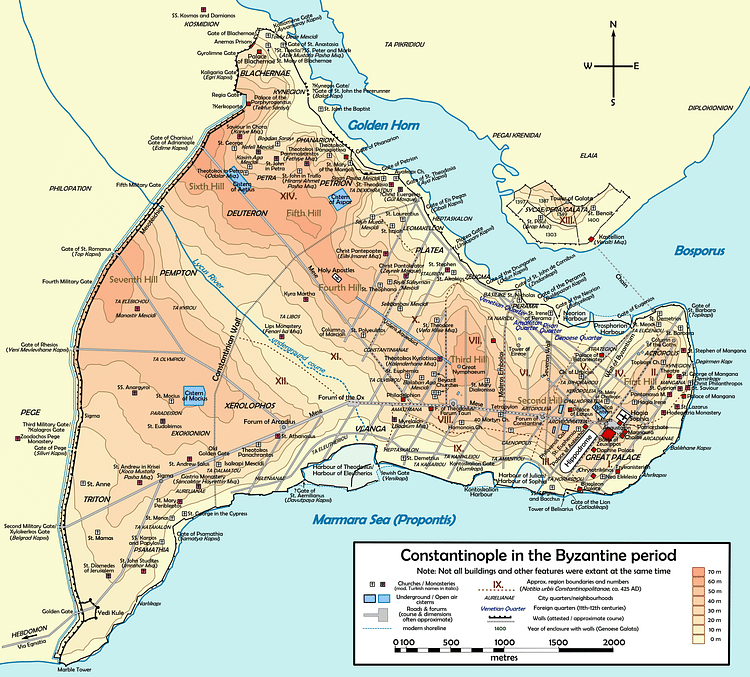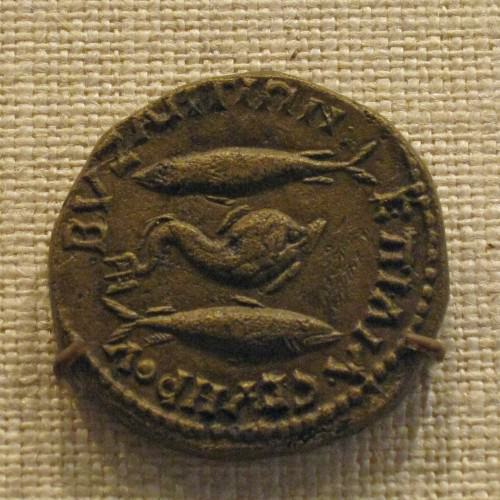Hadrian › Byzantium » Ancient origins
Articles and Definitions › Contents
- Hadrian › Who Was
- Byzantium › Antique Origins
Ancient civilizations › Historical and archaeological sites
Hadrian › Who Was
Definition and Origins

Hadrian was Roman emperor from 117 to 138 CE and he is known as the third of the Five Good Emperors ( Nerva, Trajan, Hadrian, Antoninus Pius, and Marcus Aurelius ) who ruled justly. Born Publius Aelius Hadrianus, probably in Hispania, Hadrian is best known for his substantial building projects throughout the Roman Empire and, especially, Hadrian's Wall in northern Britain.
EARLY LIFE
As a young man, Hadrian was well educated in his hometown of Italica Hispania (modern day Seville, Spain) and left for Romearound the age of 14. His first military service was as Tribune under Emperor Nerva. When Nerva died, Trajan ascended to the throne. Emperor Trajan was the first Roman ruler of provincial origin. Later biographers would attempt to place the birth of both Trajan and Hadrian in the city of Rome but both were of Hispanic ethnicity and this commonality has been assumed by some to be the reason for Trajan's adoption of Hadrian as his successor (though most scholars dispute this). Trajan died on campaign in Cilicia in 117 CE, with Hadrian in command of his rear guard, and is not believed to have named a successor.Trajan's wife, Plotina (who was fond of Hadrian) signed the papers of succession and it is thought that she, not the emperor, was responsible for Hadrian's adoption as heir. However that may be, it is known that Trajan respected Hadrian and had considered him as his successor even if he did not officially name him as such. Hadrian's service to Trajan is well documented through the various important positions he held prior to becoming emperor of Rome.
HADRIAN IS COMMONLY DEPICTED IN MILITARY ATTIRE EVEN THOUGH HIS REGIME IS MARKED BY RELATIVE PEACE.
HADRIAN AS EMPEROR
His popularity as emperor is attested to by the fact that Hadrian was absent from Rome for the better part of his reign. Earlier Roman rulers, such as Nero, were harshly criticized for spending less time away from the city. Professor D. Brendan Nagle writes that Hadrian “spent most of his reign (twelve out of twenty-one years) traveling all over the Empire visiting the provinces, overseeing the administration, and checking the discipline of the army. He was a brilliant administrator who concerned himself with all aspects of government and the administration of justice” (278). His devotion to the army was such that he would sleep and eat among the common soldiers and he is commonly depicted in military attire even though his regime is marked by relative peace.
Hadrian's building projects are perhaps his most enduring legacy. He established cities throughout the Balkan Peninsula, Egypt, Asia Minor, and Greece. His love for Greece and Greek literature was such that he was known as `Graeculus' (Greekling) in his youth and his philhellenism did not dissipate with age. He visited Greece at least twice (probably more) and participated in the Eleusinian Mysteries, of which he was an initiate. The Arch of Hadrian, constructed by the citizens of Athens in 131/132 CE, honor Hadrian as the founder of the city. Inscriptions on the arch name Theseus (the traditional founder) but add Hadrian owing to the latter's substantial contributions to Athens (such as the Temple of Zeus ). He dedicated a number of sites in Greece to his young lover Antinous, who drowned in the Nile River in 130 CE. Hadrian was deeply attached to Antinous and the young man's death so greatly affected the emperor that he had him deified (from which the mystery cult in honor of Antinous grew). In Egypt he founded the city of Antinopolis in his memory. In Rome he rebuilt the Pantheon (which had been destroyed by fire) and Trajan's Forum as well as funding construction of other buildings, baths, and villas. Many of these structures survived intact for centuries, some as late as the 19th century CE, and the Pantheon, still perfectly preserved, may be visited in the present day. Hadrian had a great interest in architecture and seems to have contributed ideas, or even plans, to the architects though scholars no longer believe that he was the lead architect on any single project.

Hadrian
HADRIAN'S WALL
Of all his significant monuments and buildings, Hadrian's Wall in north Britain is the most famous. Construction of the wall, known in antiquity as Vallum Hadriani, was begun around 122 CE and corresponded to Hadrian's visit to the province. It marked the northern boundary of the Roman Empire in Britain but the length and breadth of the project (stretching, as it did, from coast to coast) suggests that the more important purpose of the wall was a show of Rome's power. The wall was originally 9.7 feet wide (3 metres) and 16-20 feet high (six metres) east of the River Irthing, all built of stone, and 20 feet wide (6 metres) by 11.feet high (3.5 metres) west of the river, made up of stone and turf, stretching 73 miles (120 km) across uneven terrain. It was built in six years by the legions stationed in Britain. There were between 14-17 fortifications along the length of the wall and a Vallum (a ditch purposefully constructed of earthworks) which ran parallel to the wall. The Vallum measured 20 feet (6 metres) wide by 10 feet (3 metres) deep flanked by large mounds of tightly packed earth. As Hadrian's foreign policy was “peace through strength” it is thought that the wall, which was originally plastered and white washed, would have clearly represented the might of the Roman Empire.
JERUSALEM
Although Hadrian was a learned and cultivated man, his policy of peaceful relations and negotiations was not always adhered to. In 130 CE, Hadrian visited Jerusalem, which was still in ruins from the First Roman-Jewish War of 66-73 CE. He rebuilt the city according to his own designs and renamed it Aelia Capitolina Jupiter Capitolinus after himself and the king of the Roman gods. When he built a temple to Jupiter on the ruins of the Temple of Solomon (the so-called Second Temple, considered sacred by the Jews), the populace rose up under the leadership of Simon bar Kokhbah in what has come to be known as bar Kokhbah's Revolt (132-136 CE). Roman losses in this campaign were enormous but Jewish losses were no less significant. By the time the rebellion was put down, 580,000 Jews had been killed and over 1000 towns and villages destroyed. Hadrian then banished the remaining Jews from the region and renamed it Syria Palaestina after the traditional enemies of the Jewish people, the Philistines. He ordered a public burning of the Torah, executed the Jewish scholars, and prohibited the practice and observance of Judaism.

Hadrian in Military Armour
DEATH & SUCCESSOR
His health now failing, Hadrian returned to Rome and occupied himself by writing poetry and tending to administrative affairs.He named as his successor Antoninus Pius on the stipulation that Antoninus would adopt the young Marcus Aurelius to follow.Hadrian died in 138 CE, presumably of a heart attack, at the age of 62. He was buried first at Puteoli, on the grounds of the former estate of the Rhetorician Cicero (as homage to Hadrian's love of learning) but when Antoninus Pius completed the great Tomb of Hadrian in Rome the following year, his body was cremated and the ashes interred there with his wife and son.Antoninus Pius had Hadrian deified and temples built in his honor. The historian Gibbon writes that Hadrian's rule was, “the period in the history of the world during which the condition of the human race was most happy and prosperous…when the vast extent of the Roman Empire was governed by absolute power under the guidance of virtue and wisdom” (61). Although Hadrian was not universally admired during his life, or since his death, his reign is generally considered in keeping with Gibbon's estimation.
Byzantium › Antique Origins
Definition and Origins

The ancient city of Byzantium was founded by Greek colonists from Megara around 657 BCE. According to the historian Tacitus, it was built on the European side of the Strait of Bosporus on the order of the “god of Delphi ” who said to build “opposite the land of the blind”. This was in reference to the inhabitants of Chalcedon who had built their city on the eastern shore of the Strait; the west side was considered far more fertile and better suited for agriculture. Although the city accepted the alphabet, calendar and cults of Megara, much of the city's founding still remains unknown. The region would remain important to the Greeks as well as the Romans. While it lay in a highly fertile area, the city was far more important due to its strategic location. Not only did it stand guard over the only entrance into the Black Sea but it also lay by a deep inlet --- The Golden Horn --- meaning the city could only be attacked from the west..
Because of its location the city became the center of the continued war between the Greeks and Persians. During the Greek and Persian Wars, the Byzantines initially supported Darius I in his Scythian campaign providing him with ships, but turned against him later. Darius destroyed the city, making the entire area part of the Achaemenid Empire in 513 BCE. During the Ionian Revolt, Greeks forces captured the city but were unable to maintain control, losing it to the invading Persians. Many of the residents of both Byzantium and Chalcedon fled, fearing reprisals from the Persians. The Spartan general, Pausanias, victorious against the Persians at Plataea in 478 BCE, traveled northward and conquered the city, becoming its governor. With the Persians so close, he made peace with the Persian king Xerxes, possibly offering to help the Persians to conquerGreece. He remained Byzantine governor until 470 BCE when he was recalled by the Spartans.
ALTHOUGH AN ALLY OF THE ROMAN EMPIRE AND IN MANY WAYS BECOMING VERY ROMANIZED, BYZANTIUM REMAINED FAIRLY INDEPENDENT.
Throughout the Peloponnesian War between Sparta and Athens, the area had split loyalties. The Athenians wanted to control Byzantium because they needed to import grain through the Strait from the Black Sea, and the Spartans wanted the city to stop the grain flow to Athens. Its prosperous economy benefited Athens, and because of this the city had been made part of the Delian League ; however, the high tributes the city had to pay to Athens --- and the fact that Athens was losing the war --- forced them to switch sides to Sparta in 411 BCE. The Spartan general Clearchus easily seized the city. This switch allowed Sparta to stop vital grain shipments through the Strait to Athens. When the Athenian leader Alcibiades outwitted the Spartans in battle in 408 BC, Clearchus abandoned the city, and the area again became Athenian. Later, however, Sparta regained control when Lysander defeated the Athenians in 405 BCE. This final defeat cut off the Athenian food supply, forcing them to surrender to Sparta in 404 BCE, thereby ending the Peloponnesian War. The following year Byzantium faced a threat from the Thracians to the west and sought help of Sparta who took control of the city. Around 390 BCE the city changed hands again when the Athenian general Thrasybulus ended Spartan power.
In 340 BCE Phillip II of Macedonia laid siege to Byzantium. The city had initially contacted Phillip when threatened by Thrace;however, when they refused to side with Phillip and turn against Athens, he attacked but soon retreated after the Persian army threatened war. His son, Alexander the Great, understood the strategic value of the city and annexed the area when he moved across the Bosporus into Asia Minor on his way to defeat Darius III and conquer the Persian Empire. The city would regain its independence under his more feeble successors. Byzantium continued to exert control over trade through the Strait, but when the island of Rhodes refused to pay the exorbitant fees, war erupted. The war was quickly settled, and the city agreed to reduce its harsh policies.

Bronze Coin of Byzantium
Although becoming an ally of the Roman Empire and in many ways becoming very Romanized, Byzantium remained fairly independent, acting as a stopping off point for Roman armies on their way to Asia Minor. The fishing, agriculture, and tributes from ships passing through the Strait made it a valuable source of income for Rome. In 192 AD after Emperor Commoduswas assassinated, a war emerged over who would succeed him. When the city refused to support Septimus Severus, supporting Pescennius Niger of Syria instead, the future emperor laid siege and destroyed the city. He would later regret his actions --- due to the influence of his son Caracalla ---and rebuild it,
When Emperor Diocletian divided the Roman Empire into his tetrachy (rule by four), Byzantium fell into the eastern half, ruled by Diocletian. The Emperor Constantine came into power in the western half in 312 AD and would soon reunite the empire when he defeated Licinius at the Battle of Chrysopolis in 324 AD. He would build his new capital on the site of ancient Byzantium, New Rome; it would become the cultural and economic center of the east. Upon Constantine's death in 337 CE, the city would be renamed Constantinople in his honor. Although the city maintained it role as an important part of the Byzantine Empire, it would be invaded and captured by the Ottoman Turks In 1453. For further information refer to the definition on Constantinople.
LICENSE:
Article based on information obtained from these sources:with permission from the Website Ancient History Encyclopedia
Content is available under License Creative Commons: Attribution-NonCommercial-ShareAlike 3.0 Unported. CC-BY-NC-SA License